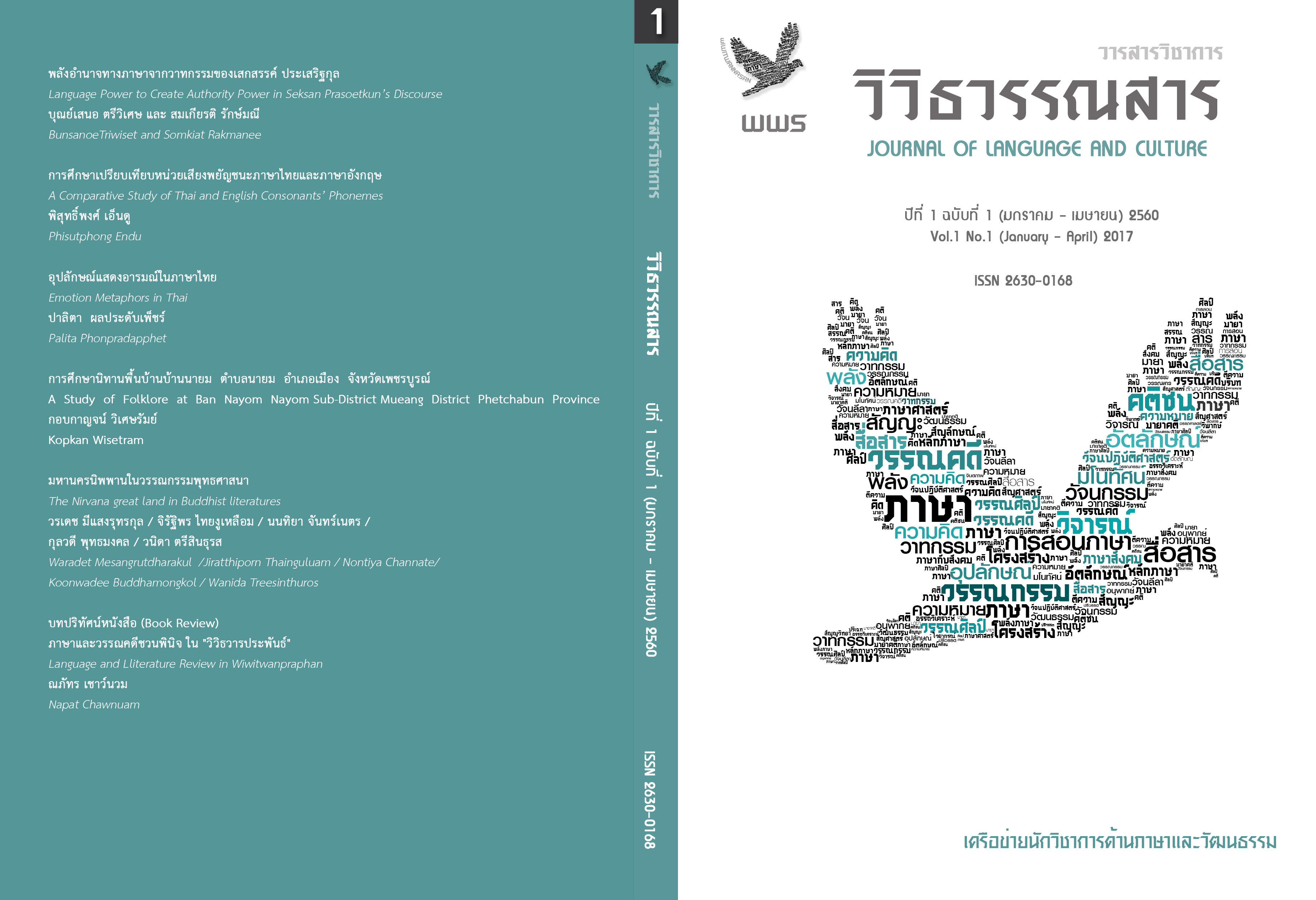มหานครนิพพานในวรรณกรรมพุทธศาสนา
Main Article Content
บทคัดย่อ
งานวิจัยนี้มีวัตถุประสงค์ 1. เพื่อศึกษาประวัติและเนื้อหาสาระสำคัญ 2. เปรียบเทียบความคิดทางปรัชญาเรื่องนิพพานในฐานะของอัตตาและอนัตตา 3. วิเคราะห์ความสัมพันธ์ของแนวคิดเรื่องนิพพานในฐานะของอัตตาและมหานครนิพพานในวรรณกรรมพุทธศาสนาสมัยหลังกับนิพพานที่ปรากฏในคัมภีร์มิลินทปัญหาวิสุทธิมรรค และมูลมัธยมกการิกาของ นาคารชุน ผลการศึกษาพบว่า 1. ด้านประวัติและสาระทั้งสามคัมภีร์แต่งขึ้นในช่วงพุทธศตวรรษที่ 3-18 โดยมีสาระสำคัญกล่าวถึงหลักอภิปรัชญาและนิพพานตามแนวคิดพุทธศาสนาในสมัยนั้น 2. ด้านการเปรียบเทียบปรัชญาทั้งสามคัมภีร์มีการพัฒนาความคิดมาจากพุทธศาสนาแบบดั้งเดิมที่ยึดหลักอนัตตา ซึ่งเป็นหลักธรรมที่ขัดแย้งกับความเชื่อเรื่อง อัตตา หรือ อาตมัน โดยมีหลักการว่า การพ้นทุกข์ (นิพพาน), การดับทุกข์ (นิโรธ) และ ของว่างในจักรวาล (อวกาศ) มีสภาวะไม่มีที่สิ้นสุดไม่อาจคำนวณได้สิ่งเหล่านี้เรียกว่า อสังขตธรรม เพียงแต่ในมูลมัธยมกการิกาของนาคารชุนอธิบายว่า ความว่างเปล่า (สุญญตา) เพื่อปฏิเสธให้เห็นว่า แม้แต่อสังขตธรรมก็ไม่ควรเอาอัตตาของฮินดูเข้ามาเกี่ยวข้อง 3. วิเคราะห์ความสัมพันธ์ของแนวคิดเรื่องนิพพาน แสดงให้เห็นว่าเรื่องมหานิพพานนครธรรมนี้ปรากฏในวรรณกรรมไทยที่เก่าแก่คือไตรภูมิพระร่วง ได้สะท้อนภาพความคิดของคนไทยในสมัยสุโขทัยนั้นเช่นเดียวกับความเชื่อในคัมภีร์พุทธศาสนาในชั้นหลังเช่น อนาคตวงศ์ อาพาธสูตรบางสำนวน เป็นต้น ที่กล่าวถึงมหานครนิพพานที่มีสภาพเหมือนสวรรค์ไว้อย่างเด่นชัดเพื่อให้ชาวไทยเห็นภาพเป็นรูปธรรมชัดเจนขึ้นซึ่งเป็นการผนวกความเชื่อเรื่องอัตตาของศาสนาฮินดูเข้ามาในพุทธศาสนาอย่างไม่ตั้งใจ อันเป็นที่มาของความคิดเรื่องนิพพานเป็นอัตตาภายในสังคมไทยปัจจุบัน
Article Details
ลิขสิทธิ์ของบทความเป็นของวารสาร การพิมพ์ซ้ำจะต้องได้ร้บการอนุญาตจากบรรณาธิการวารสาร
เอกสารอ้างอิง
Bangkok: Thai-Tibet Studies Center.
Kalupahana, D.J. (1999). Mulamadhyamakakarika of Nagarjuna. Delhi: MotilalBanarsidass.
Mahamakut Buddhist University. (1997). Wisutthimak Plae Phak 3 Ton 1. (InThai)
[Translation of Visuddhimagga Vol 3 Part 1], (7th Edition) Bangkok: Mahamakut
Buddhist University Press.
Mahamakut Buddhist University. (1997). Wisutthimak Plae Phak 3. Ton Chop. (InThai)
[Translation of Visuddhimagga.Vol 3 Part 3], (7th Edition). Bangkok: Mahamakut
Buddhist University Press.
Mahamakut Buddhist University.(1972). Milintha Panha Chabap Plae Nai Maha Makut
Ratcha Witthayalai. (In Thai) [MilindaPanha: A Thai Version by Mahamakut
Buddhist University]. Bangkok: Mahamakut Buddhist University. (Published by
Royal Order in Cremation of Supreme Patriarch (ChuanUtthayi) at Crematory of
Wat ThepSirinthawat on June 17,1972)
Mahamakut Buddhist University. (2000). Prasut Lae Atthakatha Plae Sangyuta Nikai
Nithan Wak Lem 2. (In Thai) Translation of Pali and Commentary:
NidanaVaggaof SamyuttaNikaya Vol 2. (4th Edition). Bangkok: Mahamakut Buddhist
University Press.
Na Bangchang, S. (1983). Prawat Wannakhadi Bali Nai India Lae Langka. (In Thai)
[The Pali Literature of India and Sri Lanka]. Bangkok: Chulalongkorn University.
Panyawattano, P.W. (2002). Kansueksa Choeng Wikhro Rueang Uppamakatha Nai
Milinthapanha. (In Thai) [An Analytical Study of the Simile Discussion in
MilindaPanha]. Master’s Thesis, The Program of Buddhism,
Mahachulalongkornrajavidyalaya University.
Phantharangsi, S. (2000). Phutthasatsana Mahanikai. (In Thai) [Mahayana Buddhism].
Bangkok: Sukhaphanchai.
PhraBrahmagunabhorn (P.A. Pautto). (2011). Phatthana Sangkhom Thai Duai Khwamru
Khaochai Triphum. (In Thai) [Development of Thai Society by Knowledge of
Traiphum]. Bangkok: Thammasapha.
PhraBrahmagunabhorn (P.A. Payutto). (2014). Phutthatham: Chabap Prap Khayai.
(In Thai) [Buddhadhamma: Enlarged Edition]. Bangkok: Mahachulalongkornrajavidyalaya
University Press.
PhraThampidok (P.A. Payutto). (1988). Phutthatham: Chabap Prapprung Lae
Khayaikhwam. (In Thai). [Buddhadhamma: Revised and Enlarged Edition].
(4th Edition). Bangkok: Mahachulalongkornrajavidyala. (Published on March 5,
2531as Souvenir in the 72th Birthday Anniversary of Mr. Tong SaeNgow)
Ratchawat, S. (2016). Payasisut: Lakthan kan Patiset Lae Yuenyan Lok Na Samai
Phutthakan. (In Thai). [Payasisutra: A Testimony on Negation and Assertion of
the Next World at Buddha’s Period]. Proceeding on National Symposium on
Humanities: Reality and Power of Dream, conducted on November14-15, 2016,
Faculty of Humanities, Chiang Mai University.
Sattayawatthana, C. (2010). Boekfa Wannakam 2: Phak song Wannakam Phutthasatsana.
(In Thai). [Literature Review 2: A Buddhist Literature]. Bangkok: Nuanchan.
Vidya, P.L. (1960). ‘Saddharmapundarikasutra’ Buddhist Sanskrit texts-no.6. India:
Mithila Institute.


